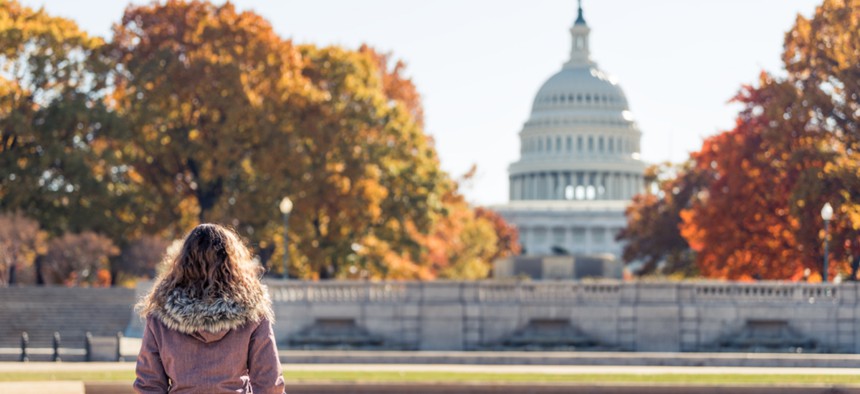Women Still Underrepresented in Elected Office at All Levels of Government, Report Says

Only 18 percent of governors and 29 percent of state legislators are women, according to the report, and women hold only 25 percent of the available seats in the Senate and 23 percent in the House. Shutterstock
Despite record numbers of women serving in Congress, women remain a minority at the local, state and federal levels of government, according to data released this week.
Despite gains in the 2018 midterm election, women remain a minority across all levels of government, according to data released this week.
The 2019 Gender Parity Index, released annually by Maryland-based nonprofit RepresentWomen, found that “women are underrepresented at the national, state, and local level, and that parity for men and women in elected office is unlikely to occur without structural changes in recruitment, electoral, and legislative rules.”
Gender parity in this case refers to when women and men hold an equal number of seats in a government body. It is important, from city councils to Congress, RepresentWomen says, because a diverse makeup more accurately reflects the communities that legislators are elected to represent.
“Electing more women to every level of government will strengthen our democracy by making it more representative, reviving bipartisanship and collaboration, encouraging a new style of leadership, and building greater trust in our elected bodies,” the report said.
Women made gains last year, particularly at the federal level, where 127 now serve in Congress—more than at any other point in history. But across the governmental spectrum, women are far from reaching parity. Women hold just 25 percent of available seats in the U.S. Senate (25 out of 100) and 23 percent of available seats in the U.S. House (102 of 435). Only 18 percent of governors and 29 percent of state legislators are women, while only 22 percent of mayors are female in cities with 30,000 people or more.
The gender parity index examines those metrics and scores each state based on women’s representation at the local, state (both governors and legislative) and federal levels. A score of 50 percent represents gender parity, with women and men holding equal numbers of seats.
Not a single state met that mark this year, and only six states—New Hampshire, Washington, Maine, Nevada, New Mexico and Michigan—are within 10 points of that goal, according to the data.
“A total of 14 states are now 60 percent of the way to parity (with scores of 30 and up), which is twice as many as there were in 2018, though the majority of states remain well behind this goal,” the report says.
New Hampshire ranked first, with a score of 49.1. Three of the state’s four Congressional seats are held by women, roughly 34 percent of its state legislators are women and two of its five largest cities have female mayors. In 2012, the report notes, “New Hampshire was the first state in the nation to elect an all-female delegation to Congress, and the state repeated this feat in 2016.” Washington (47.4), Maine (43), Nevada (42.3) and New Mexico (42.2) round out the top five.
Utah ranked last in the nation with a parity index score of 8.2, edging out Louisiana (8.4). Utah has no women in its congressional delegation or in any of its statewide offices. Six of Utah’s 23 cities have women mayors, but there are no women serving as county executives. Twenty-four percent of seats in the Utah state legislature are held by women, up from 14 percent in 1993. Montana (10.6), Arkansas (11.3) and Texas (11.6) are also in the bottom five.
States on the west coast have generally had better gender parity in government, while the Midwest and Southeast have lagged behind—and that gap is growing. In last year’s report, a majority of West Coast states scored between 25 and 32.9 points, while this year, most scored between 33 points and 49.9 points. But Midwest and Southeast states made virtually no progress in that time period.
“For the United States to achieve parity, more needs to be done in support of women candidates in these states,” the report says.
Fixing the problem will require more than simply identifying and training potential female candidates, said Cynthia Richie Terrell, founder and executive director of RepresentWomen.
“Changing rules and systems to create equality is part of the American tradition,” she said in a statement. “To win gender parity in our lifetimes, we must pivot to system reforms that include gender targets for PACs and political parties so more women run, fair representation voting systems so more women win, and updated legislative practices so more women can serve and lead once elected.”
Kate Elizabeth Queram is a Staff Correspondent for Route Fifty and is based in Washington, D.C.
NEXT STORY: Deaths Attributed to Those With Concealed Carry Permits Tracked in New Report





